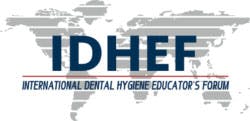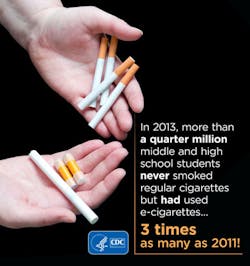This issue's introduction: Canadian 'global' meeting, obesity, tobacco, CE app
By Maria Perno Goldie, RDH, MS
I am very excited to announce the next meeting of the International Dental Hygiene Educator’s Forum (IDHEF)! The IDHEF and the Canadian Dental Hygienists Association (CDHA) invite you to join us in 2015 at the beautiful Fairmont Hotel, Victoria, BC, Canada. For more details about the meeting, click here for a downloadable invitation. (Add hyperlink: http://www.dentistryiq.com/articles/2014/09/canadian-meeting-initiates-global-exchange-of-information-for-hygienists.html)
In this issue, we discuss a number of important issues. A variety of cancers, HIV/AIDS, and other public health issues are highlighted. Also recently reported: Obesity, or a higher body mass index (BMI), is connected to 10 common cancers and over 12,000 cases every year.1 This was the largest study of its kind on BMI and cancer, involving more than 5 million adults in the United Kingdom (UK).
The authors estimate that if the average BMI in the population continues to increase, there could be over 3,500 extra cancers every year as a result of obesity. This is a global problem, and as waistlines increase, so do diabetes and cardiovascular diseases.
In the study, each 5 kg/m² increase in BMI was noticeably linked with higher risk of cancers of the uterus (62% increase), gall bladder (31%), kidney (25%), cervix (10%), thyroid (9%), and leukemia (9%). Higher BMI also increased the overall risk of liver (19% increase), colon (10%), ovarian (9%), and breast cancers (5%), but the effects on these cancers were affected by underlying BMI and by individual-level factors such as sex and menopausal status. There was limited evidence that those with high BMI were at a slightly reduced risk of prostate cancer and premenopausal breast cancer.
Peter Campbell, MD, of the American Cancer Society in Atlanta, wrote: "We have sufficient evidence that obesity is an important cause of unnecessary suffering and death from many forms of cancer, in addition to the well-recognized increased risks of mortality and morbidity from many other causes. More research is not needed to justify, or even demand, policy changes aimed at curbing overweight and obesity.”
On a positive note, a 12-year study showed that eating habits have improved a bit, except among the poor.3 On an index of healthy eating where a perfect score is 110, U.S. adults averaged just 40 points in 1999-2000, rising increasingly to 47 points in 2009-10. Scores for low-income adults were lower than the average and hardly moved during the time of the study. They averaged almost four points lower than those for high-income adults at the beginning of the study, and the variance increased to more than six points in 2009-10.
Higher scores indicate a larger consumption of heart-healthy foods, including vegetables, fruits, whole grains, and healthy fats. They also indicate a lower risk of obesity and chronic illnesses including heart disease, strokes, and diabetes. Low scores mean people face larger odds for developing those conditions.
Regarding e-cigarettes, the American Heart Association (AHA) has issued a new statement.4 Electronic cigarettes present a challenge for public health officials. They do contain fewer carcinogenic substances found in tobacco products, and may pose less of a health hazard if used. The AHA statement recommends that physicians counsel patients to use e-cigarettes when other smoking cessation approaches fail.
Alternatively, teenagers who do not smoke cigarettes but use e-cigarettes, may in time begin smoking traditional cigarettes. This concern has caused recommendations against e-cigarette use by many health leaders. They consider e-cigarettes as a recreational item for teens than as a genuine smoking cessation tool. They favor nicotine patches, gum, and lozenges, which are regulated by the U.S. Food and Drug Administration as medical products. See more on e-cigarettes in the first article.
More than a quarter of a million teens who had never smoked a cigarette used electronic cigarettes in 2013, according to national survey data that was published last week by Centers for Disease Control and Prevention researchers.5 This compares to 79,000 non-smoking teens who reported using e-cigarettes in a 2011 National Youth Tobacco survey. The data show that adolescents who had never smoked conventional cigarettes but who used e-cigarettes were almost twice as likely to have intentions to smoke conventional cigarettes as those who had never used e-cigarettes.
In the third article, we discuss head and neck cancer and HPV infection. In light of the rampant increase of the incidence of human papillomavirus (HPV)-related oropharyngeal squamous cell carcinomas (OPSCC), we are now seeing a “new” head and neck cancer patient. They are young, nonsmokers, nondrinkers, and HPV positive.
According to the authors of a new article, these patients are very different from those with the traditional risk factors.6 The article reviews the evaluation of the HPV-related cancer patient, including a review of the HPV-positive oropharyngeal cancer epidemic from the surgeon’s perspective, evaluation of the primary lesion, evaluation of the neck mass, and role of imaging, to provide a framework for addressing the challenging questions that may be posed by patients. Clinicians must be prepared to suitably evaluate, counsel, and treat these patients with HPV-positive disease with the anticipation that traditional treatment algorithms will evolve to maintain or improve current excellent cure rates while lessening treatment related side effects.
Lastly, there is a new app (My CE App) that features tools to help licensed professionals keep track of their CE credits. Medical doctors, dental hygienists, dentists, lawyers, financial consultants, engineers, and other licensed professionals can use it to gain access to personalized resources through membership. The user interface is simple to use and allows you to track courses and easily email your CE list or print a PDF. A seamless tool for busy professionals at no cost.7 The app is available in the iTunes store.8
In 2014, the autumnal equinox brings the fall season to the northern hemisphere on September 22 at 10:29 p.m. EDT. As you read this, I am en route to Italy to enjoy beautiful Tuscany! I hope you enjoy the fall season and this newsletter!
References
- Bhaskaran K, Douglas I, Forbes H, dos-Santos-Silva I, Leon DA, and Smeeth L. Body-mass index and risk of 22 specific cancers: a population-based cohort study of 5·24 million UK adults. The Lancet, 2014; 755-765. DOI: 10.1016/S0140-6736 (14)60892-8.
- Campbell PT. Commentary. Body-mass index and risk of 22 specific cancers: a population-based cohort study of 5·24 million UK adults. The Lancet, 2014; DOI: 10.1016/S0140-6736(14), 727-728.
- Wang DD, Leung CW, Li Y, et al. Trends in Dietary Quality Among Adults in the United States, 1999 Through 2010. JAMA Intern Med. Published online September 01, 2014. doi:10.1001/jamainternmed.2014.3422.
- Bhatnagar A, Whitsel LP, Ribisl KM, et al. AHA Policy Statement: Electronic Cigarettes: A Policy Statement From the American Heart Association, on behalf of the American Heart Association Advocacy Coordinating Committee, Council on Cardiovascular and Stroke Nursing, Council on Clinical Cardiology, and Council on Quality of Care and Outcomes Research. Circulation. 2014; CIR.0000000000000107published online before print August 24 2014, doi:10.1161/CIR.0000000000000107.
- CDC Press Release. http://www.cdc.gov/media/releases/2014/p0825-e-cigarettes.html.
- Deschler DG, Richmon JD, Khariwala SS, Ferris RL, and Wang MB. The “New” Head and Neck Cancer Patient—Young, Nonsmoker, Nondrinker, and HPV Positive Evaluation. Otolaryngol Head Neck Surg, vol. 151 no. 3, 375-380, September 2014.
- https://aceaglobal.com/.
- https://itunes.apple.com/app/my-ce-track-your-continuing/id773054887.







